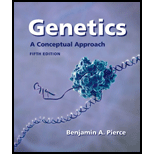
To determine:
The degree of similarities in the genomes of humans and chimpanzees.
Introduction:
The theory that humans and African great apes share common ancestors was proposed by Charles Darwin over 140 years ago. Now, there are significant and enough genetic evidence that prove that chimpanzees are the closest relative to humans.
Explanation of Solution
The fossil studies give evidence that the genetic divergence of chimpanzee and humans occurred around only 5 to 7 million years ago. The differences in
Despite large phenotypic differences, the genome sequencing of chimpanzee and human DNA show remarkable similarities. About 96% of human and chimpanzee DNA is similar with variations in just 1% of DNA along with 3% in deletions and insertions.
To determine:
The genetic changes responsible for the large differences in the anatomy, physiology, and behavior of humans and chimpanzees.
Introduction:
Despite the presence of 96% similarities in the DNA sequence of humans and chimpanzees, there is a great degree of phenotypic differences in both species.
Explanation of Solution
The difference in the genomes of human and chimpanzee is just 1%. There are various phenotypic differences in humans and chimpanzees like in the structure of bones, backbone, pelvis, jaw, teeth, skull, feet and hands. The size of the brain in humans is also more than twice of chimpanzees, and humans show characteristics of complex language and culture which are not exhibited in chimpanzees.
The explanation that how the even very small amount of genetic change (1%) have accounted for that much phenotypic differences between humans and chimpanzees is explained by regulatory sequences of the genome that regulate expression of genes. These small changes may affect the expression of different types of genes and simultaneously influence phenotypic traits.
Some scientists have identified such 90 transcription factors whose gene expression is significantly different between chimpanzees and humans. Alteration in a small number of regulatory sequences influenced the expression of various genes that produced large phenotypic differences in humans and chimpanzees.
There is 96% similarity between the genomes of humans and chimpanzees. Despite this much of genetic similarity, the difference in the regulatory sequence of the genome, there is the very large phenotypic difference between two species.
Want to see more full solutions like this?
Chapter 17 Solutions
Genetics
- Molecular Biology Explain/discuss how “slow stop” and “quick/fast stop” mutants wereused to identify different protein involved in DNA replication in E. coli.arrow_forwardMolecular Biology Question A gene that codes for a protein was removed from a eukaryotic cell and inserted into a prokaryotic cell. Although the gene was successfully transcribed and translated, it produced a different protein than it produced in the eukaryotic cell. What is the most likely explanation?arrow_forwardMolecular Biology LIST three characteristics of origins of replicationarrow_forward
- Molecular Biology Question Please help. Thank you For E coli DNA polymerase III, give the structure and function of the b-clamp sub-complex. Describe how the structure of this sub-complex is important for it’s function.arrow_forwardMolecular Biology LIST three characteristics of DNA Polymerasesarrow_forwardMolecular Biology RNA polymerase core enzyme structure contains what subunits? To form holo enzyme, sigma factor is added to core. What is the name of the structure formed? Give the detailed structure of sigma factor and the function of eachdomain. Please help. Thank youarrow_forward
- Molecular Biology You have a single bacterial cell whose DNA is labelled with radioactiveC14. After 5 rounds of cell division, how may cells will contain radioactive DNA? Please help. Thank youarrow_forward1. Explain the structure and properties of atoms and chemical bonds (especially how they relate to DNA and proteins). Also add some pictures.arrow_forward1. In the Sentinel Cell DNA integrity is preserved through nanoscopic helicase-coordinated repair, while lipids in the membrane are fortified to resist environmental mutagens. also provide pictures for this question.arrow_forward
- Explain the structure and properties of atoms and chemical bonds (especially how they relate to DNA and proteins). Also add some pictures.arrow_forwardIn the Sentinel Cell DNA integrity is preserved through nanoscopic helicase-coordinated repair, while lipids in the membrane are fortified to resist environmental mutagens. also provide pictures for this question.arrow_forward1. Explain how genetic information is stored, copied, transferred, and expressed. Also add some pictures for this question.arrow_forward
 Human Anatomy & Physiology (11th Edition)BiologyISBN:9780134580999Author:Elaine N. Marieb, Katja N. HoehnPublisher:PEARSON
Human Anatomy & Physiology (11th Edition)BiologyISBN:9780134580999Author:Elaine N. Marieb, Katja N. HoehnPublisher:PEARSON Biology 2eBiologyISBN:9781947172517Author:Matthew Douglas, Jung Choi, Mary Ann ClarkPublisher:OpenStax
Biology 2eBiologyISBN:9781947172517Author:Matthew Douglas, Jung Choi, Mary Ann ClarkPublisher:OpenStax Anatomy & PhysiologyBiologyISBN:9781259398629Author:McKinley, Michael P., O'loughlin, Valerie Dean, Bidle, Theresa StouterPublisher:Mcgraw Hill Education,
Anatomy & PhysiologyBiologyISBN:9781259398629Author:McKinley, Michael P., O'loughlin, Valerie Dean, Bidle, Theresa StouterPublisher:Mcgraw Hill Education, Molecular Biology of the Cell (Sixth Edition)BiologyISBN:9780815344322Author:Bruce Alberts, Alexander D. Johnson, Julian Lewis, David Morgan, Martin Raff, Keith Roberts, Peter WalterPublisher:W. W. Norton & Company
Molecular Biology of the Cell (Sixth Edition)BiologyISBN:9780815344322Author:Bruce Alberts, Alexander D. Johnson, Julian Lewis, David Morgan, Martin Raff, Keith Roberts, Peter WalterPublisher:W. W. Norton & Company Laboratory Manual For Human Anatomy & PhysiologyBiologyISBN:9781260159363Author:Martin, Terry R., Prentice-craver, CynthiaPublisher:McGraw-Hill Publishing Co.
Laboratory Manual For Human Anatomy & PhysiologyBiologyISBN:9781260159363Author:Martin, Terry R., Prentice-craver, CynthiaPublisher:McGraw-Hill Publishing Co. Inquiry Into Life (16th Edition)BiologyISBN:9781260231700Author:Sylvia S. Mader, Michael WindelspechtPublisher:McGraw Hill Education
Inquiry Into Life (16th Edition)BiologyISBN:9781260231700Author:Sylvia S. Mader, Michael WindelspechtPublisher:McGraw Hill Education





